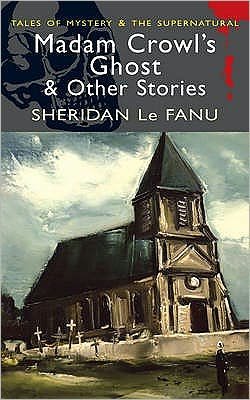
Tell your friends about this item:
Schalken the Painter
Sheridan Le Fanu
Schalken the Painter
Sheridan Le Fanu
Publisher Marketing: Joseph Thomas Sheridan Le Fanu (28 August 1814 - 7 February 1873) was an Irish writer of Gothic tales and mystery novels. He was the leading ghost-story writer of the nineteenth century and was central to the development of the genre in the Victorian era. Three of his best known works are Uncle Silas, "Carmilla" and The House by the Churchyard. Sheridan Le Fanu was born at 45 Lower Dominick Street, Dublin, into a literary family of Huguenot origins. His parents were Thomas Philip Le Fanu and Emma Lucretia Dobbin. Both his grandmother Alicia Sheridan LeFanu and his great-uncle Richard Brinsley Sheridan were playwrights (his niece Rhoda Broughton would become a successful novelist). Within a year of his birth his family moved to the Royal Hibernian Military School in the Phoenix Park, where his father, a Church of Ireland clergyman, was appointed to the chaplaincy of the establishment. The Phoenix Park and the adjacent village and parish church of Chapelizod would appear in Le Fanu's later stories. In 1826 the family moved to Abington, County Limerick, where Le Fanu's father Thomas took up his second rectorship in southern Ireland. Although he had a tutor, Le Fanu also used his father's library to educate himself. His father was a stern Protestant churchman and raised his family in an almost Calvinist tradition. In 1832 the disorders of the Tithe War (1831-1836) affected the region. There were about six thousand Catholics in the parish of Abington, and only a few dozen members of the Church of Ireland. (In bad weather the Dean cancelled Sunday services because so few parishioners would attend.) However, the government compelled all farmers, including Catholics, to pay tithes for the upkeep of the Protestant church. The following year the family moved back temporarily to Dublin, to Williamstown Avenue in a southern suburb, where Thomas was to work on a Government commission. Although Thomas Le Fanu tried to live as though he were well-off, the family was in constant financial difficulty. Thomas took the rectorships in the south of Ireland for the money, as they provided a decent living through tithes. However, from 1830, as the result of agitation against the tithes, this income began to fall and it ceased entirely two years later. In 1838 the government instituted a scheme of paying rectors a fixed sum, but in the interim the Dean had little besides rent on some small properties he had inherited. In 1833 Thomas had to borrow 100 from his cousin Captain Dobbins (who himself ended up in the debtors' prison a few years later) to visit his dying sister in Bath, who was also deeply in debt over her medical bills. At his death Thomas had almost nothing to leave to his sons and the family had to sell his library to pay off some of his debts. His widow went to stay with the younger son William. Contributor Bio: Le Fanu, Sheridan Joseph Thomas Sheridan Le Fanu was an Irish writer of Gothic tales and mystery novels. Born in 1814, he was the premier ghost story writer of the nineteenth century and had a seminal influence on the dev
| Media | Books Paperback Book (Book with soft cover and glued back) |
| Released | April 21, 2014 |
| ISBN13 | 9781499214000 |
| Publishers | Createspace |
| Pages | 42 |
| Dimensions | 129 × 198 × 2 mm · 49 g |
More by Sheridan Le Fanu
Others have also bought
See all of Sheridan Le Fanu ( e.g. Paperback Book , Hardcover Book , Sewn Spine Book , Audiobook (CD) and Bound Book )

 Christmas presents can be returned until 31 January
Christmas presents can be returned until 31 January















![Cover for Sheridan Le Fanu · In a Glass Darkly (Paperback Book) [Deseret Alphabet edition] (2016)](https://imusic.b-cdn.net/images/item/original/306/9781539179306.jpg?sheridan-le-fanu-2016-in-a-glass-darkly-paperback-book&class=scaled&v=1641944505)


















![Cover for May Sinclair · Udenlandsk fugl: Krystallens defekt (Sewn Spine Book) [1st edition] (2023)](https://imusic.b-cdn.net/images/item/original/352/9788794026352.jpg?may-sinclair-2023-udenlandsk-fugl-krystallens-defekt-sewn-spine-book&class=scaled&v=1680185942)
![Cover for Harald Kidde; Thit Jensen; Sigurd Mathiesen; Holger Rygaard-Hansen; Sten Drewsen; Thomas Krag; Johannes V. Jensen; R. Jahn Nielsen; L.C. Nielsen; Astrid Ehrencron-Kidde · Serie for grotesker: Vildsindet (Sewn Spine Book) [1st edition] (2022)](https://imusic.b-cdn.net/images/item/original/515/9788794025515.jpg?harald-kidde-thit-jensen-sigurd-mathiesen-holger-rygaard-hansen-sten-drewsen-thomas-krag-johannes-v-jensen-r-jahn-nielsen-l-c-nielsen-astrid-ehrencron-kidde-2022-serie-for-grotesker-vildsindet-sewn-spine-book&class=scaled&v=1666618604)
![Cover for Alan Moore · Nemo: River of Ghosts (Hardcover Book) [UK edition] (2015)](https://imusic.b-cdn.net/images/item/original/333/9780861662333.jpg?alan-moore-2015-nemo-river-of-ghosts-hardcover-book&class=scaled&v=1459332374)
![Cover for Christopher Egeberg · SPYO's København (Hardcover Book) [1st edition] (2024)](https://imusic.b-cdn.net/images/item/original/299/9788794091299.jpg?christopher-egeberg-2024-spyo-s-koebenhavn-hardcover-book&class=scaled&v=1699637182)
![Cover for Astrid Ehrencron-Kidde, Ingeborg Johansen, Carl Gandrup, Johan Plesner, Gustav Bauditz, Laurids Skands, Karin Michaëlis, Thorkil Barfod · Serie for grotesker: Menneskekød (Sewn Spine Book) [1st edition] (2019)](https://imusic.b-cdn.net/images/item/original/628/9788797083628.jpg?astrid-ehrencron-kidde-ingeborg-johansen-carl-gandrup-johan-plesner-gustav-bauditz-laurids-skands-karin-michae-lis-thorkil-barfod-2019-serie-for-grotesker-menneskekoed-sewn-spine-book&class=scaled&v=1558120769)
![Cover for Louis Levy · Serie for grotesker 1: Menneskeløget Kzradock, den vårfriske Methusalem (Sewn Spine Book) [2nd edition] (2017)](https://imusic.b-cdn.net/images/item/original/234/9788799617234.jpg?louis-levy-2017-serie-for-grotesker-1-menneskeloeget-kzradock-den-vaarfriske-methusalem-sewn-spine-book&class=scaled&v=1497601357)
![Cover for José-Louis Bocquet og Jean-Luc Fromental · Blake og Mortimer: Blake og Mortimer: Otte timer i Berlin (Bound Book) [1st edition] (2022)](https://imusic.b-cdn.net/images/item/original/738/9788770859738.jpg?jose-louis-bocquet-og-jean-luc-fromental-2022-blake-og-mortimer-blake-og-mortimer-otte-timer-i-berlin-bound-book&class=scaled&v=1664164397)
![Cover for Jean Van Hamme · Blake og Mortimer: Blake og Mortimer: Den sidste Sværdfisk (Bound Book) [1st edition] (2021)](https://imusic.b-cdn.net/images/item/original/922/9788770858922.jpg?jean-van-hamme-2021-blake-og-mortimer-blake-og-mortimer-den-sidste-svaerdfisk-bound-book&class=scaled&v=1633156669)
![Cover for Jan Sonnergaard · Gyldendals Paperbacks: Jeg er stadig bange for Caspar Michael Petersen (Paperback Book) [3rd edition] [Paperback] (2012)](https://imusic.b-cdn.net/images/item/original/029/9788702136029.jpg?jan-sonnergaard-2012-gyldendals-paperbacks-jeg-er-stadig-bange-for-caspar-michael-petersen-paperback-book&class=scaled&v=1447751972)
![Cover for Thomas More · Utopia (Sewn Spine Book) [2nd edition] (2017)](https://imusic.b-cdn.net/images/item/original/990/9788702209990.jpg?thomas-more-2017-utopia-sewn-spine-book&class=scaled&v=1472935285)
![Cover for Lars Henriksen; Thomas Kim Rasmussen; Marcel de Sade · Verden vil betages (Bound Book) [1st edition] (2018)](https://imusic.b-cdn.net/images/item/original/706/9788702226706.jpg?lars-henriksen-thomas-kim-rasmussen-marcel-de-sade-2018-verden-vil-betages-bound-book&class=scaled&v=1531481662)
![Cover for James Baldwin · Gyldendal Skala: Giovannis værelse (Bound Book) [1st edition] (2019)](https://imusic.b-cdn.net/images/item/original/499/9788702256499.jpg?james-baldwin-2019-gyldendal-skala-giovannis-vaerelse-bound-book&class=scaled&v=1540113952)
![Cover for Kaspar Colling Nielsen · Mount København (Paperback Book) [3rd edition] (2018)](https://imusic.b-cdn.net/images/item/original/611/9788702272611.jpg?kaspar-colling-nielsen-2018-mount-koebenhavn-paperback-book&class=scaled&v=1532862760)
![Cover for Lasse Raagaard Jønsson · Ssn Snnart (Sewn Spine Book) [1st edition] (2021)](https://imusic.b-cdn.net/images/item/original/493/9788702315493.jpg?lasse-raagaard-joensson-2021-ssn-snnart-sewn-spine-book&class=scaled&v=1608074266)
![Cover for Fjodor Dostojevskij · Rosinantes Klassikerserie: Forbrydelse og straf (Sewn Spine Book) [3rd edition] (2010)](https://imusic.b-cdn.net/images/item/original/799/9788763814799.jpg?fjodor-dostojevskij-2010-rosinantes-klassikerserie-forbrydelse-og-straf-sewn-spine-book&class=scaled&v=1332799212)
![Cover for Pierre Christin og Jean-Claude Mézières · Linda og Valentins samlede eventyr: Linda og Valentin: Retur til fremtiden (Bound Book) [1st edition] (2019)](https://imusic.b-cdn.net/images/item/original/482/9788770857482.jpg?pierre-christin-og-jean-claude-mezieres-2019-linda-og-valentins-samlede-eventyr-linda-og-valentin-retur-til-fremtiden-bound-book&class=scaled&v=1545238045)